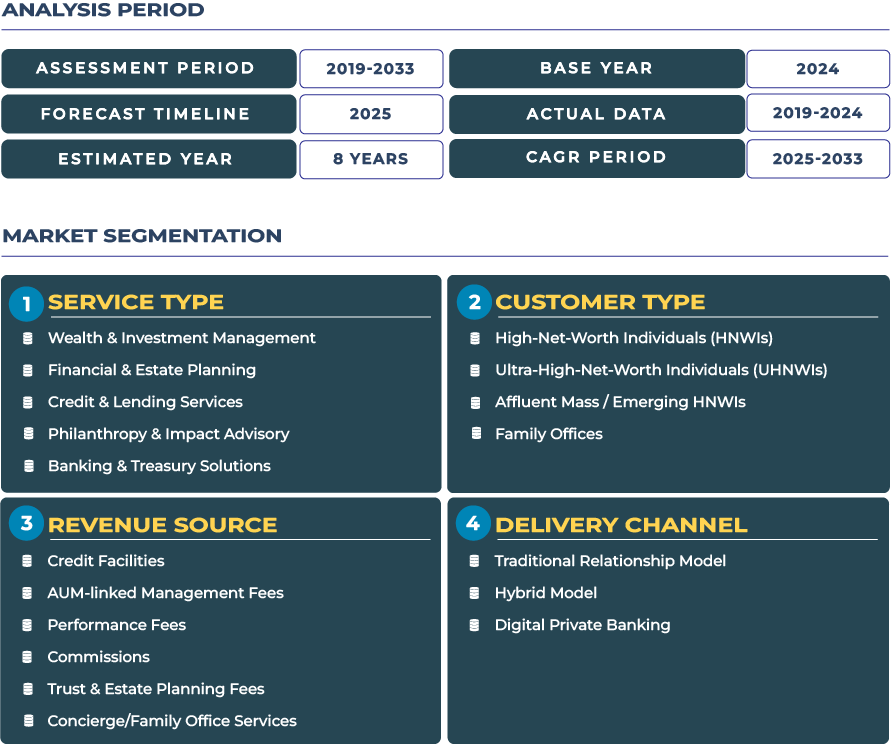Market Outlook: Strategic Horizon for Western Europe’s Private Banking Ecosystem Over the Next Decade
The outlook for Western Europe’s private banking market presents both a measured growth trajectory and a transformative imperative. With the market size projected to rise from USD 249.4 billion in 2025 to USD 320.3 billion by 2033-reflecting a CAGR of approximately 3.2%-the performance will be underpinned by rising high-net-worth individual (HNWI) wealth, increasing demand for integrated wealth management, and the shift toward digital and cross-border service models. However, this growth is modest relative to emerging markets, emphasising that success in Western Europe will be defined by deepening value per client rather than acquisition of volume alone.
Note:* The market size refers to the total revenue generated by banks through various services.
Amid persistent inflation, muted growth, rising regulatory scrutiny and global geopolitical instability, Western European private banking firms must focus on resilience and agility. For instance, demand is growing for sophisticated lending solutions (securities-based lending, real-estate-backed credit), payments and treasury services embedded within wealth platforms, and insurance/bancassurance products aligned with investor risk-management and legacy planning. Institutions that embed digital engagement, personalised advisory and cross-jurisdictional wealth structuring will position themselves to capture the 3.2% CAGR. In summary, market participants must move beyond static advisory models toward adaptive value-chain orchestration and client-journey excellence.
Growth Catalysts & Growth-Barriers: What Propels and What Impedes Western Europe’s Private Banking Market
Key growth catalysts. Several drivers are underpinning the Western Europe private banking market’s forward momentum. First, persistent wealth accumulation among affluent individuals in mature markets (UK, Germany, France) increases the addressable base for private banking services. Second, the shift toward digital wealth-ecosystems enables private banks to enhance client engagement, reduce cost-to-serve and deliver integrated solutions spanning lending, payments, deposits and investment advisory. Third, regulatory transparency and compliance requirements mean affluent clients often gravitate toward established private banks with strong reputations, global reach and robust governance frameworks.
Growth-barriers and headwinds. Nevertheless, the Western Europe private banking sector faces material impediments. Profit-pool compression has been a recurring theme-with margins under pressure and cost-income ratios deteriorating. For example, research indicates private-banking profit pools in Western Europe fell 1.5% in 2019 and aggregate profit margins are historically low relative to assets under management. Economic headwinds-such as inflation and interest-rate volatility-curtail discretionary investment flows and raise risk-aversion among affluent clients. Geopolitical tensions, regulatory fragmentation (e.g., post-Brexit divergence), and competition from wealth-tech entrants further challenge traditional models. The result: growth is obtainable, but only through operational transformation rather than simply asset flow volume.
Trend-Lines & Opportunity Frames: Realigning Private Banking for Digital, ESG and Next-Gen Wealth in Western Europe
Prominent emerging trends. Western Europe’s private banking landscape is shaped by several key trends. Digital-wealth adoption is accelerating, with clients expecting seamless mobile/hybrid advisory, integrated payments and real-time liquidity management. ESG (environmental, social and governance) integration is now mainstream; affluent clients are seeking sustainability-aligned portfolios, impact-investing and purpose-driven wealth strategies. Additionally, alternative investments-private markets, real-estate, private credit-are gaining traction as low-yield environments persist.
Opportunity frames. Private banks in Western Europe have multiple directed opportunities. First, next-gen affluent clients (millennials and Gen Z) offer growth potential if banks align digital, thematic and experience-rich propositions. Second, regional hubs such as London, Frankfurt, Zurich and Luxembourg retain strengths in cross-border advisory and international wealth structuring; institutions that optimise booking-centre capabilities can gain share. Third, embedding payments and treasury flows into the private-banking journey-such as real-time cross-border transfers, e-wallets for wealthy clients and bullion-backed credit lines-can deepen client relationships and wallet share. Lastly, ESG-led wealth solutions present differentiation: by offering sustainability-linked lending, impact investment options and philanthropy-advisory modules, banks can meet rising client demands and regulatory drivers simultaneously.
Regional Breakdown: Country-Level Snapshots in Western Europe’s Private Banking Sector
UK: The UK remains a dominant private-banking hub globally, supported by London’s wealth-management infrastructure, legal/tax advisory capabilities and depth of capital markets. Post-Brexit regulatory shifts and tax changes (e.g., non-dom regimes) are shaping client behaviour and wealth flows.
Germany: As the largest continental market, Germany features strong entrepreneurial and family-business wealth. Private banking growth is driven by lending overlay on portfolios, next-gen digital platforms and increasing interest in private-markets access.
France: France’s private banking landscape benefits from high-net-worth client density, robust estate-planning demand and inbound wealth flows. Cross-border advisory (particularly within Europe) remains pivotal.
Italy: Italy offers mature wealth-management opportunity with sizeable family-business wealth but comparatively lower private-banking penetration; digital-first models and alternative-asset access are emerging growth areas.
Spain: Spain is evolving as a private-banking growth node thanks to wealth-migration, residency-incentive regimes and rising domestic affluence; payment/treasury integration and regionalisation will be key.
Benelux: Belgium, Netherlands and Luxembourg remain strategic as booking-centres for cross-border wealth; Luxembourg continues as fund-structuring and private-banking hub within the region.
Nordics: The Nordics combine high digital-services adoption with wealth creation from technology sectors and strong governance, offering fertile ground for digital-first private banking propositions.
Competitive Landscape: Strategic Moves Defining Western Europe’s Private Banking Battleground
The competitive terrain in Western Europe’s private banking market is increasingly strategic and selective. One noteworthy deal: BNP Paribas Wealth Management signed a deal in September 2024 to acquire the private-banking unit of HSBC in Germany-expected to close in Q2 2025, increasing its assets under management significantly and reinforcing its euro-zone leadership. Consolidation among larger players is driving scale and enhancing digital-wealth capabilities.








